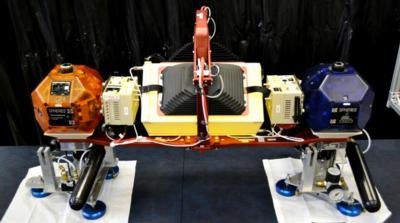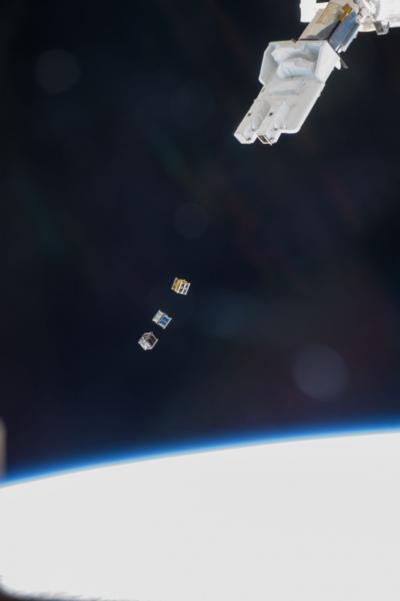Launch From Wallops Planned For January 8
Delivering ants to space, sloshy fluids for robotic satellites, a study on antibiotic drug resistance and other small satellites to the International Space Station can be a tough job, and now Orbital Sciences Corporation of Dulles, VA, can help carry the load. In its first commercial resupply journey after completion of NASA’s Commercial Orbital Transportation Services program, the Orbital-1 mission will deliver some very interesting new scientific investigations to the space station.

Orbital’s Antares rocket is planned to launch Jan. 8 from Wallops Flight Facility in eastern Virginia. Antares is scheduled to deliver the Cygnus spacecraft full of new research investigations, supplies and other space station hardware to the space station on Jan. 12.
One of the new research investigations traveling to the orbiting laboratory is the Commercial Generic Bioprocessing Apparatus Science Insert - 06: Ants in Space (CSI-06). Students in grades K-12 will observe videos of these “ant-ronauts” recorded by cameras on the space station. The students will also conduct their own ant interaction investigations in their classrooms as part of a related curriculum. Educational investigations such as Ants in Space are designed to motivate budding scientists in primary and secondary school to pursue their interest in the science, technology, engineering and mathematics fields.
The Ants in Space study examines the behavior of ants by comparing groups living on Earth to those in space. The idea is that ant interactions are dependent upon the number of ants in an area. Measuring these interactions may be important in determining behavior of ants in groups. This insight may add to existing knowledge of swarm intelligence, or how the complex behavior of a group is influenced by the actions of individuals. Developing a better understanding of swarm intelligence may lead to more refined mathematical procedures for solving complex problems, like routing trucks, scheduling airlines or telecommunications efficiency.
A second investigation launching with the Orbital-1 mission is the SPHERES-Slosh study. SPHERES-Slosh will use the existing space station facility of free-flying satellites known as Synchronized Position Hold, Engage, Reorient, Experimental Satellites (SPHERES). The goal is to look at how liquids slosh around inside containers in microgravity, showing how applied external forces impact the contents of those containers. The experiments simulate how rocket fuels move around inside their tanks in response to motor thrusts used to push a rocket through space. The study of the physics of liquid motion in microgravity is important because Earth’s most powerful rockets use liquid fuels to take satellites and other spacecraft into orbit. Having a deeper understanding of rocket propellants may lower the cost of industry and taxpayer-funded satellite launches by improving fuel efficiency.
A third investigation aboard the Cygnus spacecraft is a study of drug-resistant bacteria. Drug-resistant bacteria are of increasing concern to public health. As bacteria grow more resistant to antibiotics, there are less effective pharmaceutical treatment options for people with bacterial infections. Researchers for the Antibiotic Effectiveness in Space (AES-1) investigation aboard the space station look to determine gene expression patterns and changes using E. coli. This research builds upon previous space station investigations into drug-resistant bacteria, such as the National Laboratory Pathfinder Vaccine Methicillin-resistant Staphylococcus aureus (NLP-Vaccine-MRSA) study of what is commonly referred to as staph infection.
The findings from AES-1 may help improve antibiotic development on Earth. Improving the efficacy of antibiotics and reducing their resistance to bacteria is a priority for health care professionals.

Small, relatively inexpensive satellites, collectively referred to as CubeSats, will provide a variety of technology demonstrations using the NanoRacks Smallsat Deployment Program to launch the satellites from the station’s Japanese Experiment Module (JEM) airlock. The NanoRacks CubeSats are deployed using the JEM Small Satellite Orbital Deployer (J-SSOD). View the illustrated simulation to see how these small satellites are deployed into space.
Using crowdsourcing methods for funding, the NanoRacks-ArduSat-2 investigation will test advanced electronics and hardware in the space environment with only minimal adaptation. Built and operated by NanoSatisfi of San Francisco, sensors on the NanoRacks-ArduSat-2 are set to determine potential commercial applications for CubeSat data collection and commercial off-the-shelf electronics. Testing these sensors through this mini-satellite format may contribute to technological information that helps lower the cost of applications that use low-Earth observation techniques.
Another small satellite investigation, the NanoRacks-Planet Labs–Dove Flock-1, will use a fleet of 28 CubeSats -- individually known as the Dove satellites -- to capture imagery of Earth for use in humanitarian and environmental applications. Built and operated by Planet Labs Inc. of San Francisco, imagery from these CubeSats will help pinpoint areas for disaster relief and improving growth of agricultural products in developing countries around the globe. In addition, information from the Dove CubeSats will focus on environmental protection measures, such as monitoring deforestation and changes to polar ice caps. The data collected by Planet Labs' CubeSats will be freely available for anyone to use.
A third example of some of the CubeSats launching with the Orbital-1 mission is the NanoRacks-SkyCube, developed by Southern Stars Group LLC of San Francisco. NanoRacks-SkyCube will provide an educational demonstration of the capabilities of CubeSats. To get the attention of the public, NanoRacks-Skycube will tweet from space via Twitter, capture imagery in orbit and use a balloon during its de-orbit and reentry into Earth’s atmosphere.
These are only a few of the many investigations headed to the space station this month. Students will closely observe ant behavior, fluids will slosh about in contained spaces, drug-resistant bacteria will be scrutinized and CubeSats will test their capabilities in orbit after being deployed from the space station. For 15 years, investigations have been underway every day aboard the orbiting outpost. This Orbital Sciences launch will bring more research to ensure that science continues aboard the space station.
(NASA Images Top: The SPHERES-Slosh hardware used aboard the space station will help researchers study the movement of fluids in microgravity. The may assist with designing new, more efficient fuel tanks. Bottom image demonstrates how CubeSats like NanoRacks-ArduSat-2, NanoRacks-Planet Labs–Dove, and NanoRacks-SkyCube deploy from the JEM Small Satellite Orbital Deployer (J-SSOD) attached to the Kibo laboratory’s robotic arm)
 ANN's Daily Aero-Linx (04.16.24)
ANN's Daily Aero-Linx (04.16.24) Aero-News: Quote of the Day (04.16.24)
Aero-News: Quote of the Day (04.16.24) Airborne 04.10.24: SnF24!, A50 Heritage Reveal, HeliCycle!, Montaer MC-01
Airborne 04.10.24: SnF24!, A50 Heritage Reveal, HeliCycle!, Montaer MC-01 Airborne 04.12.24: SnF24!, G100UL Is Here, Holy Micro, Plane Tags
Airborne 04.12.24: SnF24!, G100UL Is Here, Holy Micro, Plane Tags Airborne-Flight Training 04.17.24: Feds Need Controllers, Spirit Delay, Redbird
Airborne-Flight Training 04.17.24: Feds Need Controllers, Spirit Delay, Redbird




